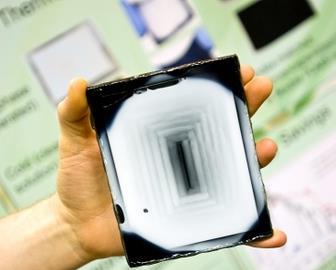A team of recent MIT graduates has developed roof tiles that change colour based on the temperature.
The tiles become white when it's hot, allowing them to reflect away most of the sun's heat. When it's cold they turn black and absorb heat when it's needed.
In their white state the tiles reflect about 80% of the sunlight falling on them, while black they reflect about 30%. That means in their white state, they could save as much as 20% of present cooling costs, according to recent studies. Savings from the black state in winter have yet to be quantified.
The tiles use a common commercial polymer in a water solution. That solution is encapsulated — between layers of glass and plastic in their original prototype, and between flexible plastic layers in their latest version — with a dark layer at the back.
When the temperature is below a certain level the polymer stays dissolved and the black backing shows through, absorbing the sun's heat. When the temperature climbs, the polymer condenses to form tiny droplets, whose small sizes scatter light and thus produce a white surface, reflecting the sun's heat.
They are now working on an even simpler version in which the polymer solution would be micro-encapsulated and the tiny capsules carried in a clear paint material that could be brushed or sprayed onto any existing surface.
The team, dubbed Thermeleon because of its colour-changing property, was one of the competitors in this year's Making and Designing Materials Engineering Contest (MADMEC) a competition for teams of MIT students.
Source
Building Sustainable Design























2 Readers' comments